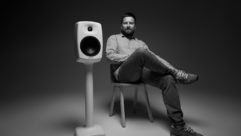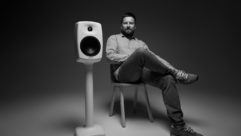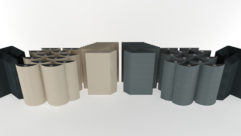Amplifier Advances
May 1, 2002 12:00 PM,
Steve Somers
Video contractors sometimes disparage the field of aural engineering by saying that a particular application or product is “merely audio.” But many audio principles can be applied to video, particularly when one is searching for greater dynamic range. Audio is about more than dynamic range or total harmonic distortion (THD), however. It’s also about power and getting more of it for less. Class D audio systems have come into their own as a practical choice for getting more audio power from a small system — or more audio power from a small battery.
AMPLIFIER CLASSES
There are five basic classes of amplifier: A, B, AB, C and D. The Class A amplifier is the traditional, fully linear amplifier with active circuit elements biased into their linear operating regions. That means that the region must have enough voltage range to encompass the entire dynamic excursion (amplitude) of an incoming signal to reproduce it without clipping or compressing at either extreme. For this reason, the amplifier’s output power supply voltage must equal roughly 200 percent of the maximum output signal swing expected. Signal amplitudes reaching the nonlinear region become distorted. This method of operation is pure but inefficient. Class A amplifiers rarely exceed 20 percent efficiency in terms of power consumed (converted to heat) versus power delivered to the load.
Class B amplifiers are somewhat more efficient because they use two drive elements operating in a push-pull configuration. On the positive excursion of the signal, the upper element supplies power to the load while the lower is turned off. During negative signal excursions, the opposite occurs. That increases operating efficiency, but the amp suffers from the nonlinear switching of the driver elements between on and off. This switching error creates a condition known as crossover distortion.
Class AB amplifiers remedy crossover distortion to a great extent by combining the best features of both A and B amplifiers. The push-pull drivers are carefully biased just above the fully off states so that the transition between drivers is smoother. Each driver is never completely off, which alleviates most of the crossover distortion, but at the expense of efficiency. A temperature-compensated bias network in close proximity to the output devices is needed. An AB amplifier is still more efficient than a Class A amplifier (as high as 65 percent efficiency); however, amplifier efficiency ratings are usually derived from application of steady-state sine wave tones having a low crest factor (ratio of peak signal to RMS signal). When taking the crest factor of real signals into account, the efficiency of both Class A and AB amplifiers drops to 20 percent at best.
Class C amplifiers, biased at or below cutoff, are commonly used for certain types of RF transmission, but are rare in audio applications.
- D DOES NOT MEAN DIGITALClass D amplifiers are not digital in the truest sense. That is, they are not driven directly by coherent binary data. However, they do behave as digital components in that the output drivers operate either in the fully on region or fully off region. Think of Class D amps as being similar to a switch-mode power supply, but with audio signals modulating the switching action.A switch-mode power supply uses pulse-width modulation (PWM) to control the on/off duty cycle of the power switching transistor or transistors providing power to a load. The efficiency is high because little voltage drop occurs across the switch transistor during conduction. That means very low power dissipation in the switch while virtually all the power is transferred to the load. During the off period, there is essentially zero current flow. The quality and speed of metal-oxide semiconductor field-effect transistor (MOSFET) devices has led to compact, efficient, high-frequency power supplies. Switch-mode power supplies are more efficient at high frequencies. At higher operating frequencies, components may become smaller, and the power supply becomes very compact for the power delivered. In addition, the output filter components may be much smaller. Today, switching frequencies above 1 MHz are not uncommon. However, switch-mode supplies generate considerable noise.What does that have to do with audio? Audio signals can be used to modulate a PWM system to create a high-power audio amplifier at nominal voltages using small components. Class D audio uses a fixed, high-frequency carrier having pulses that vary in width based on signal amplitude. Class D amplifiers reach efficiencies as high as 90 percent. That is a great benefit in portable applications that rely on battery power. Class D amplifiers can extend battery life in portable gear by two to three times or more.Equipment using Class D systems save significant operating power. For equipment having a limited power budget or voltage range, Class D can get the job done without redesigning power supplies for more signal headroom. If that sounds like a system fraught with poor performance, then you’d be surprised at the quality. Here’s a closer look at how it works.INSIDE CLASS D AMPLIFIERSClass d systems usually compare the incoming audio signal amplitude with a triangle waveform operating at the intended switching frequency. The comparator circuit switches its output to high or low based on the incoming audio’s threshold against the reference amplitude and frequency of the triangular wave. As the audio signal rises above the comparator threshold, the comparator switches on and remains on as long as the audio signal exceeds the reference level. That creates a wide, positive pulse width. Conversely, while the audio signal is below the comparator’s reference level, the negative portion of the output-pulse duty cycle is wider (see Figure 1).Some describe this conversion method as a 1-bit A/D converter. A big advantage this conversion method has is linearity: The relationship of audio amplitude to the variable width pulses in this system is perfectly linear. The fixed-frequency pulse train becomes a carrier for the audio.The outputs of the comparator connect to gate drive circuitry for the MOSFET output transistors. Typically, the comparator has complementary outputs and drives two sets of stacked transistor switches. This configuration, along with the point of connection for the loudspeaker, describes an output drive topology known as an H configuration or a bridge-tied load (see Figure 2).Most Class D designs use a Butterworth filter scheme for simplicity and low cost. The output filter is essential for lowpass filtering and integrating the carrier’s varying pulse-duty cycle into the original audio content while attenuating the switching carrier frequency. Selection of filter component values is essential to maximizing efficiency.Dynamic range is attained by selection of the carrier switching frequency. A factor of at least a dozen times the upper audio cutoff frequency is recommended. That means that the minimum switching frequency will be about 250 KHz. At rest (no signal), the duty cycle of the switching frequency is 50 percent, or evenly divided between on and off. Interestingly, the at-rest state is the most stressful for a Class D design. Positive-going signal peaks drive the duty cycle one direction, and negative-going peaks drive it the opposite direction. Thus, the higher the switching frequency, the more bits of resolution are available for signal reproduction.QUALITY AND EFFICIENCYClass d amplifiers have been criticized as delivering lower quality than Class AB systems used with lower performance applications such as P.A. systems. Through recent advances in power semiconductor devices and the need for better efficiency under battery power, Class D amps have recently seen a resurgence of interest. It is now possible to develop a Class D design that rivals most AB amplifiers.For example, look at the frequency responses in Figure 3. The top graph shows the bandpass response of a signal at 25 watts into 8 ohms. The bottom two graphs compare the signal-to-noise performance of a Class AB amplifier (15 W into 8 ohms) and a Class D amplifier (25 W into 8 ohms). Note that the performances are close and that the Class D design pumps 67 percent more power into the same load.Figure 4 shows THD performance for a Class D amplifier. It is good enough to be competitive with Class AB. It’s also interesting to note that, at full output power, the Class D output switch transistor heatsink is just warm to the touch. Its power supply voltages are one half the level needed by the Class AB device.
- CLASS D ADVANTAGESThe biggest gain is in efficiency. Improved efficiency translates into lower system cost, lower operating temperatures, lower power supply voltages and lower power consumption. In addition, Class D building blocks are readily available along with significant design support for rapid implementation into new product designs. Although real operating efficiency in Class AB amplifiers struggles at about 20 percent, Class D systems attain 75 percent efficiency without significant effort. Even higher efficiencies are possible depending on the details of the design. Higher power amplifiers (more than 100W) actually attain higher efficiencies than their low-power relatives.
- IS THERE A CATCH?Competing with Class AB designs in the name of efficiency does carry a few caveats. Of three critical design features, the output filter rates number one. The output filter reconstructs the original audio signal and attenuates the switching carrier frequency. It also sets the amplifier’s — 3 dB bandwidth. In designing the output filter, it is important to select filter topology and component values such that the switching frequency is sufficiently attenuated while the audio band is not significantly affected. Some residual carrier is always present after the filter, though. The newcomer to Class D will not see a quiet, no-signal condition at the speaker terminals. Some of the efficiency loss in Class D is the result of the output filter design.Because of high frequency operation, power supply decoupling is important. The switching carrier must be removed from all supply voltages to prevent it from degrading circuit operation. Finally, good high frequency circuit board layout technique is essential for minimizing generation of electromagnetic interfereance. As power level increases, switching currents traveling in high impedance board traces will generate significant electrical noise.
- A BRAVE NEW CLASSAdvances in the electronic art are more interdisciplinary than ever before. Class D audio applications require a wide breadth of design knowledge and technique; maintaining audio signal purity is the ultimate goal. Class D audio systems are rapidly approaching the expectations of the audiophile and winning the praises of experts in energy efficiency, too.
Steve Somers is vice president of engineering at Extron Electronics. He has more than 30 years’ experience in the video industry, including broadcast and computer monitor development and color television design support. Contact him at[email protected].










